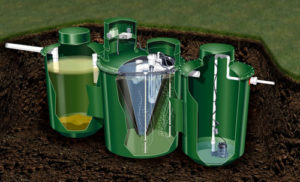
Appearing in the last ten years, aerobic systems are a new technology to remove septic waste. Depending on the manufacturer, aerobic septic waste can come under a variety of different names, such as Biocycle, Eco cycle and Enviro cycle. Most of the tanks used for the system are 7500 litres in volume, and according to manufacturer guidelines need to be emptied every four years. The aerobic system is a smaller scale sewage treatment that is similar to the septic tank system, however uses an aerobic process for digestion rather than just the anaerobic process.
There are two types of systems for aerobic wastewater treatment; aerated wastewater treatment systems (AWTS) and aerobic sand filters.
What is an AWTS?
- Designed to treat wastewater to a level suitable for surface irrigation within the site.
- Following primary treatment, the effluent is treated by a process of aeration, settling and disinfection and then pumped to a dedicated irrigation area as recycled water.
What is a sand filter?
- Sand filters achieve a similar result to AWTS but the treatment process is different.
- The effluent from a septic tank is filtered through a sand layer which provides natural aeration and biological oxidation through aerobic and nitrifying organisms.
- From the disinfection chamber the recycled water is pumped to the dedicated irrigation area. (SA Health, 2013).
How do aerobic systems differ from anaerobic (septic) sytems?
Both the aerobic and anaerobic systems use natural processes to treat wastewater, however the aerobic treatment process differs as it requires oxygen. Therefore, a mechanism is used to inject and circulate air inside the treatment tank. As this requires electricity to operate, aerobic systems are more costly than other septic systems, but can also provide higher quality treatment.
The process
The process for the aerobic system generally has four steps:
- Pre-treatment stage: large solids and other undesirable substances are removed from the wastewater.
- Aeration stage: the aerobic bacteria digest the biological wastes in the water.
- Settling stage: when any undigested solids are able to settle, forming a sludge which must be removed from the system.
- Disinfecting stage: chlorine or another disinfectant is mixed with water in order to produce an antiseptic output.
Why use an aerobic system?
Although is can be more costly to use an aerobic system, as well as it requiring electricity to function, it is a more efficient system to use. There is a significant difference in the ability of aerobic bacteria compared with anaerobic bacteria in breaking down organic material. Aerobic bacteria will generate 20 times more energy from the same amount of organic material, and will reproduce and consume organise material at a much higher rate than anaerobic. Due to these differences, converting an anaerobic tank to an aerobic tank can save a failing septic system.
Operation and Maintenance
Maintenance for the system generally includes checking blowers, pipework, valves, diffusers, effluent clarity and sludge return, removal of excess scum and testing the pump.
It is important that the filters are serviced by a trained professional, and they adhere to the guidelines of the SA Health On-site Wastewater Systems Code.
Nitschke Liquid Waste provides aerobic system and wastewater services in Adelaide. We are a fully certified and EPA licensed company, with all of our services helping you to comply with requirements as set out by SA Water.



